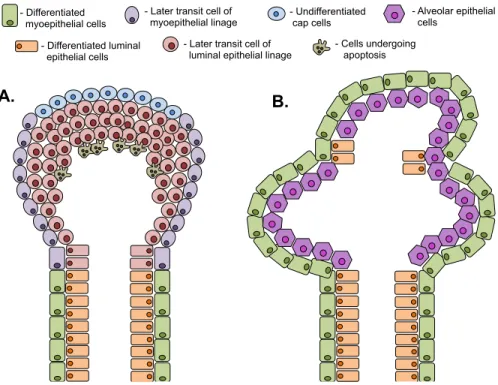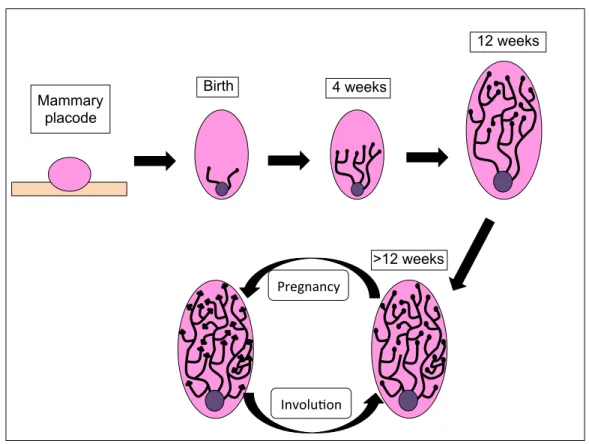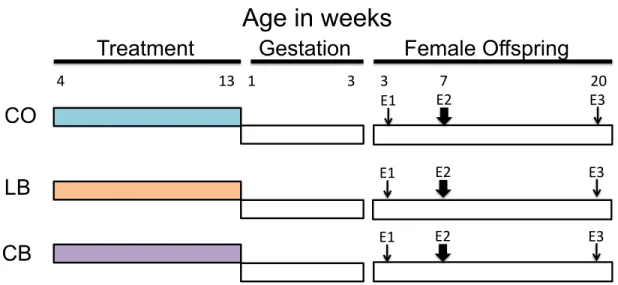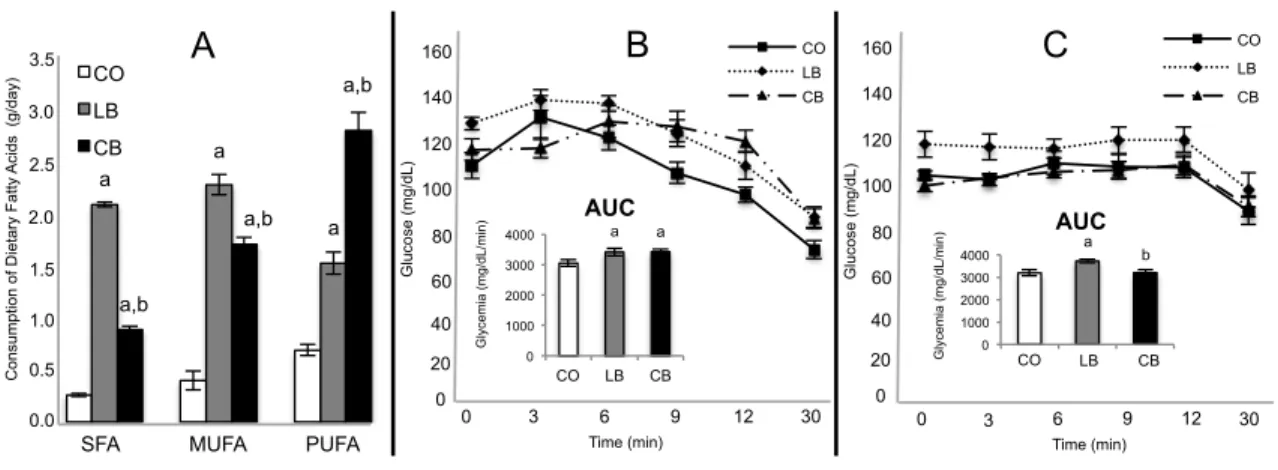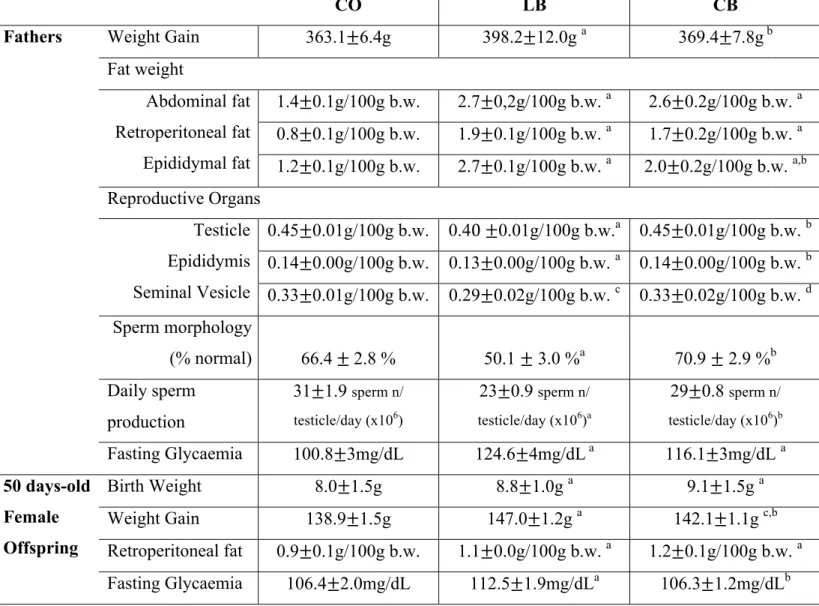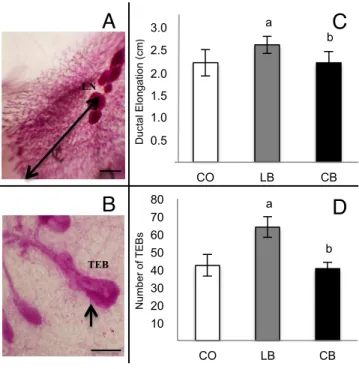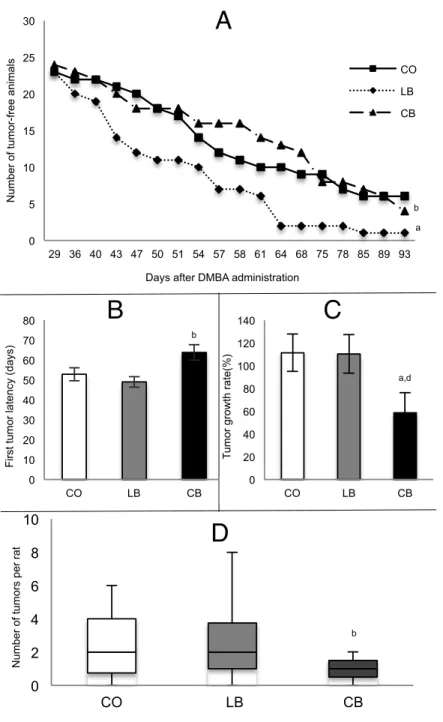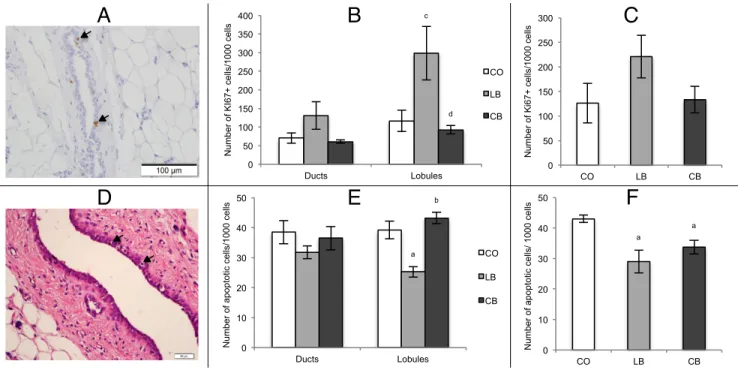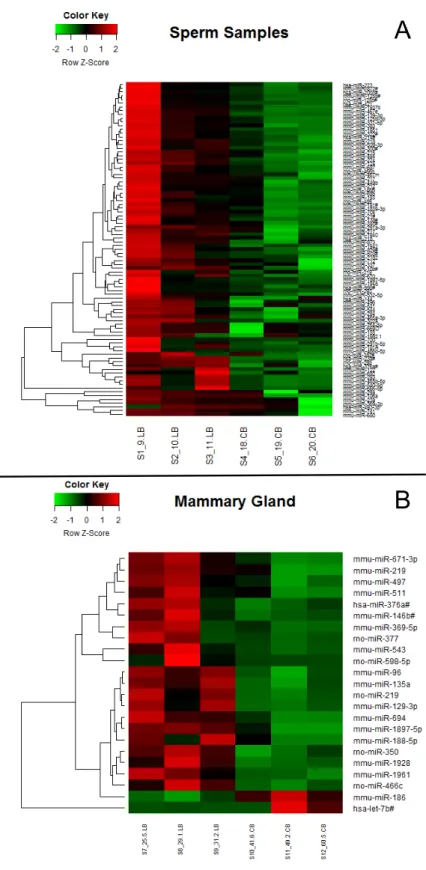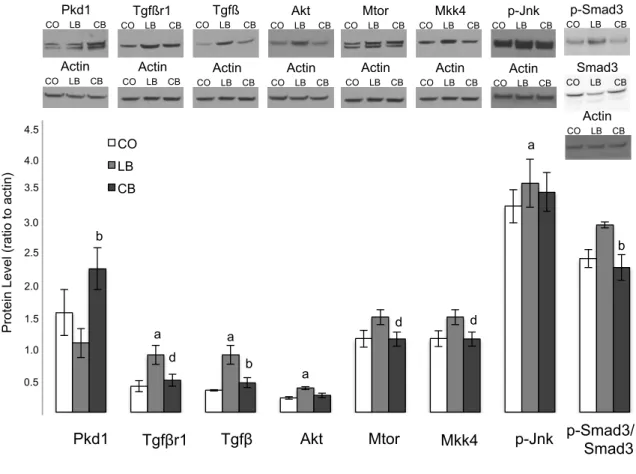UNIVERSITY OF SÃO PAULO
Faculty of Pharmaceutical Sciences
Graduate Program in Food Sciences
Area of Experimental Nutrition
Paternal pre-conceptional nutrition programs breast cancer
risk in rat female offspring: opposing effects of animal- and
plant- based high fat diets.
Camile Castilho Fontelles
UNIVERSITY OF SÃO PAULO
Faculty of Pharmaceutical Sciences
Graduation Program in Food Sciences
Area of Experimental Nutrition
Paternal pre-conceptional nutrition programs breast cancer
risk in rat female offspring: opposing effects of animal- and
plant- based high fat diets.
Camile Castilho Fontelles
Original Version
Thesis presented for the degree of
DOCTOR IN PHILOSOPHY
Supervisor: Prof. Dr. Thomas Prates Ong
Camile Castilho Fontelles
Paternal pre-conceptional nutrition programs breast cancer
risk in rat female offspring: opposing effects of animal- and
plant- based high fat diets.
Commission
of
Thesis for the degree of Doctor in Philosophy
____________________________________
1
stExaminer
____________________________________
2
ndExaminer
____________________________________
3
rdExaminer
____________________________________
4
thExaminer
____________________________________
5
thExaminer
DEDICATION
To my loving grandmother Rosa Fontelles Burgues de Pau, who
crossed an entire ocean without knowing what to expect and with
her life story and her endless love taught me to always follow my
ACKNOWLEDGMENTS
To my remarkable parents, Christine and Francisco Fontelles, who always believed
and supported me so I could follow my dreams, giving me unconditional love and being
the best people in the world;
To my baby sister Isabelle Fontelles, who makes me a better human being and a
much happier person;
To my wonderful husband Cyro Vasconcellos, who was always there when I needed
him, actively helping me in all the steps of this study, making my work more productive,
giving me advice, whipping my tears, sharing my laughs and mostly for loving me so
much. I love you honey;
To my advisor Prof. Dr. Thomas Prates Ong, for accepting me in his lab 7 years ago
when I was at my undergraduate school without many working experiences, for believing
in my potential and for encouraging me to became the scientist that I am today;
To my amazing friend Mariana Rosim, who did absolutely everything that she could
to be next to me when I needed her, for helping with my work and personal life and most
of all for being a fantastic human being that I admire and deeply love;
To my brilliant friend Luiza Guido, who I appreciate and love so much, for sharing
all the hard work and her incredible knowledge with me and for always being there for
me, but most of all for the incredible friend she is;
To Fabia de Oliveira Andrade for guiding me in this magnificent pathway called
“Research”, for teaching me almost everything I know about science, for helping each and
every time I needed her and for being a great friend;
Adriana Campos who always encouraged me, to Gabriela Costa for being a great friend,
to Vanessa Cardoso for her help whenever I needed it and to Raquel Cruz, Livia Ribeiro
and Natália Castro for their companionship;
To Bianca Scolaro for always encouraging me and to Marina Nogueira and Livia
Chassot for making my days happier. For Kelly Furtado for all the shared knowledge, to
Juliana Ortega for all the lunches and conversations, to Eduardo Latorre for always
helping me, to Ernesto Vargas-Mendez for answering all my questions about statistics and
for Bruna Zavarize and Graziela Biude for always being ready to talk about everything;
To the technicians Ivanir Pires and Renato Heidor, for always being there with a
friendly word and for helping me with all the techniques;
To Prof. Tit. Fernando Salvador Moreno, for contributing to my professional growth
and for helping me whenever I needed;
To Prof. Leena Hilakivi-Clarke, for taking me into her lab for one year and for
always being willing to discuss science and generate wonderful data;
To Prof. Sonia de Assis, for allowing me to be part of her project, for helping me and
mostly for being a great research partner;
To Prof. Inar de Castro, Luciene Lauer and Marina Nogueira for the lipid profile and
MDA analyses;
To Prof. Ana Paula de Melo Loureiro and Tiago Franco for helping me in the global
methylation analyses;
To all the employees from the Food and Experimental Nutrition Department for their
commitment to all students;
and Vinicius Fola, for always being there for me listening to me while I was talking about
things that they had no idea, always trying to understand, I love you all;
And finally to CNPq for the doctoral scholarship (153478/2012-8) and FAPESP for
“The life we want depends on what we do to it.”
FONTELLES, C.C. Nutrição paterna pré-concepcional programa o risco de câncer de mama na prole feminina de ratos: efeitos opostos de dietas hiperlipídicas de origem animal e vegetal. 2016. Tese (Doutorado) – Faculdade de Ciências Farmacêuticas, Universidade de São Paulo, 2016.
RESUMO
O câncer de mama é um persistente problema de saúde pública. Hipótese
intrigante sugere que a suscetibilidade à doença pode ser modulada em períodos precoces
da vida, fenômeno conhecido como programação fetal. Nesse sentido, a maior parte dos
estudos de programação fetal refere-se à influência materna, dada a intensa interação
existente entre mãe e feto tanto no período fetal, quanto na lactação. Entretanto, estudos
recentes mostram que a dieta paterna pré-concepcional também tem um papel de grande
importância na suscetibilidade da prole à uma série de doenças crônicas
não-transmissíveis de origem metabólica. Portanto, o presente projeto de doutorado direto teve
como objetivo avaliar se o consumo paterno de diferentes dietas hiperlipídicas, durante o
período de desenvolvimento do sistema reprodutivo de ratos machos, aumentaria a
suscetibilidade da prole feminina à carcinogênese mamária. Adicionalmente buscou-se
avaliar quais mecanismos poderiam estar envolvidos nesse processo. Utilizaram-se ratos
machos da linhagem Sprague-Dawley (n=20/grupo) que consumiram dieta hiperlipídica
com 60% de calorias provenientes de lipídeos de banha (grupo LB) ou óleo de milho
(grupo CB), ou dieta controle AIN-93G (grupo CO), por nove semanas, durante os
períodos de desenvolvimento e maturação sexual. Esses ratos foram acasalados com
fêmeas, que consumiram apenas dieta comercial, na proporção 1:1. Sua prole de 50 dias
foi submetida ao modelo de carcinogênese mamária com o uso de
animal ou vegetal conferiram efeitos opostos, com o consumo de dieta com alto teor de
ácidos graxos saturados (LB) aumentando e o consumo de dieta com alto teor de ácidos
graxos poli-insaturados n-6 (CB) diminuindo o risco de desenvolvimento de câncer de
mama na prole feminina. Esses efeitos foram associados à alteração da expressão de 89
miRNAS no espermatozoide dos pais e 23 miRNAs na glândula mamária da prole, com
sobreposição de 3 miRNAs (miR-1897-5p, miR-219-1-3p e miR-376a#) que estavam
alterados em ambos tecidos. Adicionalmente, a prole feminina de machos que
consumiram dieta com alto teor de ácidos graxos saturados apresentou menor
diferenciação da glândula mamária, maior nível de proliferação celular, menor nível de
apoptose e alteração da expressão de proteínas chaves da regulação celular, como na
transição epitélio-mesenquimal. Finalmente, essas fêmeas também apresentaram perfil
lipídico alterado semelhante à do seu progenitor masculino, bem como modificações
epigenéticas que podem estar relacionadas à etiologia do câncer de mama. Assim,
concluímos que a dieta paterna hiperlipídica pré-concepcional programou a
suscetibilidade da prole feminina à carcinogênese mamária, porém esse efeito é
dependente do tipo de ácido graxo consumido e os efeitos observados possivelmente
decorrem de alterações no perfil de expressão de miRNAs.
FONTELLES, C.C. Paternal pre-conceptional nutrition programs breast cancer risk in rat female offspring: opposing effects of animal- and plant- based high fat diets.
2016. Thesis (PhD) – Faculty of Pharmaceutical Sciences, University of São Paulo, 2016.
ABSTRACT
Breast cancer is a persistent public health problem. Interesting hypothesis suggests
that its risk can be modulated in early life periods, a phenomenon known as fetal
programming. In this context, most fetal programming studies focus on maternal
influence, due to the greater interaction between mother and fetus in both fetal and
lactation periods. However, recent studies show that paternal preconception diet has also a
major role in the offspring's susceptibility to metabolic chronic non-communicable
diseases. Therefore, this direct doctoral project aimed to assess whether the paternal
consumption of different high fat diets during the development period of the reproductive
system of male rats increased the susceptibility of female offspring to mammary
carcinogenesis. In addition we sought to evaluate which mechanisms could be involved in
this process. We used male rats of the Sprague-Dawley strain (n = 20/group) that
consumed high fat diet with 60% of calories from lipids from lard (LB group) or corn oil
(CB group), or AIN-93G control diet (CO group) for nine weeks, during development and
sexual maturation periods. These rats were mated with females who consumed only
commercial diet in 1:1 ratio. Their 50 days old offspring were subjected to mammary
carcinogenesis model using 7,12-dimethylbenz[a]anthracene (50mg/kg). Paternal
consumption of high fat diet of animal or plant source had opposite effects, with the
paternal consumption of diet with high content of saturated fatty acids (LB) increasing
and consumption of diet with high content of n-6 polyunsaturated fatty acids (CB)
due to changes in the expression of 89 miRNAs in the father’s sperm and 23 miRNAs in
the offspring’s mammary gland, with overlapping of three miRNAs (1897-5p,
miR-219-1-3p and miR-376a #) that were altered in both tissues. Additionally, female
offspring of males fed diets with high content of saturated fatty acids showed less
differentiation of the mammary gland, higher levels of cell proliferation, lower levels of
apoptosis and altered expression of keys proteins that regulate important cellular
functions, such as epithelial to mesenchymal transition. Finally, these females had also
altered lipid profile of the fat pad similar to their male parent as well as epigenetic
changes that may be related to the etiology of breast cancer. Thus, we conclude that the
high-fat preconception paternal diet programmed the susceptibility of female offspring to
mammary carcinogenesis, but this effect was dependent on the type of fatty acid
consumed and the observed effects possibly results from changes in miRNA expression
profile.
ABREVIATIONS
• AA - Arachidonic acid
• AB- Alveolar Bud
• AKT - V-akt murine thymoma viral oncogene
• ANOVA – Analysis of variance
• AOAC - Association of Official Analytical Chemists
• AUC – Area under the curve • BHT – Butylated hydroxytoluene
• BRCA1 – Breast cancer 1
• c-RAF - V- raf-leukemia viral oncogene
• CASP3 - Caspase 3
• CEBPß - CCAAT/enhancer binding protein beta
• CEUA- Animal use ethical committee
• CFL - Cofilin
• CO – Male rats fed AIN93G diet
• CB - Male rats fed corn-oil-based high fat diet
• DCIS - Ductal carcinoma in situ
• DES - Diethylstilbestrol
• DHA - Docosahexaenoic acid
• DMBA - 7,12-dimethylbenz[a]anthracene
• DNA - Deoxyribonucleic acid
• DNMT – DNA methyltransferases
• DOHaD - Developmental origins of health and disease
• DTT - Dithiothreitol
• EMT - Epithelial to mesenchymal transition
• EPA - Eicosapentaenoic acid
• ER - Estrogen receptor
• ERK1/2 – Extracelular signal-regulated kinase ½
• FASN – Fatty acid synthase
• FCF – Faculty of pharmaceuticals sciences
• GEO - Gene Expression Omnibus
• GESR - Genomics and Epigenomics Shared Resources
• H3K4 – Histone 3 lysine 4
• H3K9 - Histone 3 lysine 9
• H3K27 - Histone 3 lysine 27
• H4K16 - Histone 4 lysine 16
• H4K20 - Histone 4 lysine 20 • HAT- Histone acetylases
• HCl – Hydrogen chloride
• HDAC – Histone deacetylases
• HER2- Human epidermal growth factor receptor 2
• HMT – Histone methyltransferases
• HPLC-DAD - High-Performance Liquid Chromatography, Diode-Array Detection
• IDC - Infiltrating ductal carcinoma
• IGF1R - Insulin-like growth factor 1 receptor
• IR beta – Insulin receptor beta
• ITT – Insulin tolerance test
• KDM - Histone demethylases
• LA - Linolenic acid
• LB- Male rats fed lard-based high fat diet
• LC3B1 – Microtubule-associated protein 1 light chain 3 beta subunit 1
• LCIS - Lobular carcinoma in situ
• LSD – Least Significant Difference
• MgCl2 – Magnesium chloride
• MKK4 - Mitogen activated protein kinase 4
• MNU - 1-methyl-1-nitrosourea
• MTOR - Mechanistic target of rapamycin
• MUFA- Monounsaturated fatty acids
• NAOH – Sodium hydroxide
• NDUFB6 - NADH dehydrogenase (ubiquinone) 1β-subcomplex 6
• NF-kB - Nuclear Factor kappa-B
• P38 - Mitogen activated protein kinase 14
• p-JNK - Phosphorylated Mitogen-activated protein kinase 8
• PBS – Phosphate-buffered saline
• PCA - Principal Component Analysis
• PKD1- Protein Kinase D1
• PMSF – Phenylmethylsulfonyl fluoride
• PPAR – Peroxisome proliferator-activated receptor
• PR - Progesterone receptor
• PTEN- Phosphatase and tensin homolog
• PUFA - Polyunsaturated fatty acids
• RANKL - Receptor Activator of Nuclear Factor kappa-B Ligand
• RAS - Harvey rat sarcoma virus oncogene
• RASF1a - Ras association domain-containing protein 1a
• RIPA – Radioimmunoprecipitation assay buffer
• RNA – Ribonucleic acid
• SCLB - Somatic cell lysis buffer
• SDS- Sodium dodecyl sulfate
• SEM - Standard error of mean
• SFA - Saturated fatty acids
• SMAD 3 - Smad family member 3
• TDLU- Terminal Ductal Lobular Units
• TEB - Terminal end buds
• TGF- Transforming Growth Factor
• TGFßR1- Transforming growth factor beta receptor I
• TIMP3 - Metalloproteinase inhibitor 3
• TMS1- Target of methylation-induced silencing 1
• TNBC - Triple negative breast cancer
• USA – United States of America
LIST OF TABLES CHAPTER 1 TABLES
Table 1: Health parameters of male rats and their 50 days old female offspring from control diet (CO), lard (LB) and corn oil (CB) fed males………59
Supplementary Table 1: Ingenuity Canonical Pathway analyses of the target pathways and molecules modulated by altered miRNA from father’s sperm and 50 days old female
LIST OF FIGURES LITERATURE REVIEW
Figure 1: Schematic representation of the structure of mammary gland at different stages of differentiation. ……….………….…25
Figure 2: Schematic representation of the mammary gland development. …………...27
CHAPTER 1 FIGURES
Figure 1: Experimental Design. ………...…50
Figure 2: Paternal fatty acid consumption and insulin tolerance test………...56
Figure 3: Mammary gland development of 50 days-old female offspring of control diet (CO), lard (LB) and corn oil (CB) fed males……….…………60
Figure 4: Mammary tumorigenesis in female offspring of control diet (CO), lard (LB) and corn oil (CB) fed males………...……….………...62
Figure 5: Cell proliferation and apoptosis quantification in mammary gland and tumors………64
Figure 6: Heatmap of miRNA expression profiles………...66
CHAPTER 2 FIGURES
Figure 1: Adipose tissue lipidomic profile of control diet (CO), lard (LB) and corn oil
(CB) fed male rats………....………..97
Figure 2: Adipose tissue lipidomic profile of female offspring of control diet (CO), lard (LB) and corn oil (CB) fed male rats………..………...98
Figure 3: Principal component analysis (PCA) of lipid profile………….………...99
Figure 4: Global DNA methylation………101
Figure 5: Global histone expression………...102
Figure 6: Global protein expression….………...………...104
SUMMARY
1. LITERATURE REVIEW ... 22
Cancer ... 22
Mammary gland development ... 23
Breast Cancer ... 27
Nutrition and Cancer ... 29
Breast Cancer programming ... 35
1. OBJECTIVES ... 40
2. DESCRIPTION OF CHAPTERS ... 41
3. CHAPTER 1: Paternal programming of breast cancer risk in daughters in a rat model: opposing effects of animal and plant-based high fat diets [Published in Breast Cancer Research, 2016, 18:71, DOI: 10.1186/s13058-016-0729-x] ... 42
Abstract ... 43
Introduction ... 45
Material and Methods ... 47
Results ... 54
Paternal Dietary and Health Parameters ... 54
Female Offspring Health Parameters ... 56
Female Offspring Mammary Gland Morphology ... 58
Female Offspring Mammary Gland Tumors data ... 59
Female Offspring Mammary Gland and Tumor Cell Proliferation and Apoptosis .. 61
Protein expression in female offspring mammary gland ... 65
Discussion ... 68
Conclusion ... 72
References ... 72
4. CHAPTER 2: Paternal animal and plant-based high fat diets can program rat female offspring lipidomic fatty acid profile and epigenetic and protein expression alteration associated with breast cancer risk ... 82
Abstrasct ... 83
Introduction ... 85
Material and Methods ... 88
Results ... 92
Lipidomic Profile ... 92
Global DNA methylation ... 98
Global histones modifications ... 99
Mammary gland protein expression of female offspring of control diet, lard and corn oil fed male rats ... 101
Discussion ... 103
References ... 107
5. FINAL CONSIDERATIONS ... 116
6. REFERENCES OF LITERATURE REVIEW ... 117
1. LITERATURE REVIEW Cancer
Cancer is a wide term used to identify a large number of diseases, which have in
common the ability to proliferate uncontrollably (National Institute of Health, 2007). In
order to cancer cells evolve into its neoplastic state, they must acquire certain cancer
hallmarks, such as sustaining proliferative signals, evading growth suppressors, avoiding
immune destruction, enabling replicative immortality, tumor promoting inflammation,
activating invasion and metastasis, inducing angiogenesis, genome instability and
mutation, resisting cell death and finally deregulating cellular energetics (Hanahan &
Weinberg, 2011). By acquiring these hallmarks cancer cells, in an intrinsic relation with
tumor associated stroma, can became tumorigenic and ultimately malignant (Hanahan &
Weinberg, 2011).
Cancer development is a multi-step process, with three main steps: initiation, that
involves one or more stable changes within the cell that occur spontaneously or induced
by environmental exposure; promotion, a reversible phase, characterized by a selective
growth enhancement provoked in the initiated cells and its progeny by continuous
exposure to a promoting agent; and finally the progression, an irreversible phase, when
after consecutive alterations in the neoplasia give rise to increasingly malignant
sub-populations, resulting in further degrees of independence, invasiveness and metastasis
(Devi, 2004).
Though it was present in human beings at ancient times, cancer incidence is currently
increasing, with a significant prevalence in modern societies (David & Zimmerman,
million deaths of cancer worldwide, while for 2030 researchers estimate an increase to
21.4 million new cases and 13.2 million deaths due to the disease (Ferlay et al., 2015).
The most frequently diagnosed cancers are lung and breast cancer in men and women
respectively, both worldwide and in less developed countries, while in more developed
countries prostate and lung cancers are the most frequently diagnosed cancers in men and
women respectively (Torre et al., 2015). Further regularly diagnosed cancers worldwide
include: liver, stomach, and colorectum among men and stomach, cervix uteri and
colorectum among women (Torre et al., 2015).
High disease incidence is associated with increase governments budget expenditure
and the global costs on oncology treatment were above U$100 billion in 2014, which
represents an increase of 10.3% over these costs in the year of 2013 (American
Association for Cancer Research, 2015). More specifically in Brazil, the government
spent more than R$1.9 billion with oncologic treatment (Tribunal de Contas da União,
2011). Altogether, these data highlight the importance of research directed towards risk
reduction strategies.
Mammary gland development
Unlike other organs, during mammary gland development while the adjacent tissues
(fat, connective tissue and blood vessels) are completely mature, the gland itself remains
in an embryonic state, being stimulated only during puberty when it starts to penetrate
into the mature surrounding tissue (Russo, 2015).
The mammary gland development initiates, in humans, at the 4th embryonic week
when mammary placodes (thickening of the ectoderm) arises along the milk line that
forms the primitive mammary buds and originating the rudimentary ductal tree at birth
(Hens & Wysolmerski, 2005). In rodents at approximately 3 weeks of age, the ductal
branching towards the fat pad begins, due to hormones stimulation (Russo et al., 1990).
Figure 1: Schematic representation of the structure of mammary gland at different stages of
differentiation. A: Prepubertal and pubertal mammary gland contains ducts terminated by highly proliferative terminal end buds. B: During pregnancy there is more ductal branching and formation of alveolar structures.
The mammary ducts are capped with terminal end buds (TEBs) that are constituted
by an outer layer of undifferentiated cap cells, inner layers of luminal epithelial cells with
great proliferative rates and an apoptotic plate behind the luminal cells resulting in ductal
canalization (Humphreys et al., 1996) (Figure 1A). TEBs are considered a stem cell niche,
given its ability to differentiate into both epithelial and myoepithelial cells (Yin et al., - Differentiated
myoepithelial cells
- Differentiated luminal epithelial cells
- Later transit cell of myoepithelial linage
- Later transit cell of luminal epithelial linage
- Undifferentiated cap cells
- Cells undergoing apoptosis
- Alveolar epithelial cells
2014). In humans, the corresponding structures of TEBs are the Terminal Ductal Lobular
Units (TDLUs) that are considered sites of tumor initiation (Polyak, 2001).
Until puberty, the rudimentary mammary epithelium is subjected to abundant
exposure of growth hormones and estrogen, causing an isometric expansion and TEBs can
begin to differentiate into alveolar buds (ABs) (Gallego et al., 2001). During puberty due
to oscillating levels of estrogen and progesterone during the estrous cycle, the mammary
ductal branching morphogenesis is potentiated (Masso-Welch et al., 2000). Further
continuous rounds of proliferation and incomplete apoptosis, caused by post-puberty
ovarian hormones, result in the establishment of a complex network of ducts that infiltrate
the fat pad to its boundaries (Atwood et al., 2000).
Additional modifications occur at pregnancy, when the mammary epithelium
undergoes rapid proliferation resulting in increased branching, with the subsequent
development of alveolar epithelium that is capable of milk secretion (Oakes et al., 2008)
(Figure 1B). The weaning period is accompanied by the regression of these recently
formed alveolar epithelium due to apoptosis, leaving the ductal epithelial nearly as it was
before pregnancy (Meier-Abt et al., 2013). Figure 2 summarizes the entire mammary
gland development process.
The differentiation caused by pregnancy is one of the most significant protective
factors against breast cancer (Lee et al., 2014). In women over 25 years old the enduring
consequences of pregnancy includes a strong and life-long breast cancer protective effect
(Albrektsen et al., 2005). This effect is not exclusive to humans and among rats and mice
that were subjected to carcinogen administration, the ones that experienced pregnancy had
animals (Medina, 2005). Rodents are often used to study breast cancer given the
similarities between theirs and humans’ mammary gland development and carcinogenesis,
as well as their short life span, easy manipulation, limited genetic heterogeneity and
controlled handling environment (Líška et al., 2016). In fact, several species, for example
dogs, cats and monkeys, have been evaluated for the purpose of breast cancer research,
however only rodents presents the necessary criteria to mimic the human disease (Russo,
2015).
Figure 2: Schematic representation of the mammary gland development.
Since mammary gland development occurs during women’s life course,
environmental exposures can have a key role in affecting it, emphasizing the importance
of focusing on early life exposures for breast cancer development and breast cancer risk
Mammary placode
Birth 4 weeks
12 weeks
>12 weeks Pregnancy)
Breast Cancer
Among women, breast cancer has one of the highest incidence rate, with nearly 1.7
million new cases diagnosed in 2012, representing 25% of all cancers in women
worldwide (Ferlay et al., 2015). In the United States of America breast cancer is the
leading cause of cancer death in women aged 20 to 59 years old (Siegel et al., 2016).
Nevertheless, approximately 70% of all breast cancer deaths worldwide occur in the
developing countries, where the incidence rate is also increasing, possibly due to
increased life expectancy, urbanization and adoption of Western lifestyle (Lee et al.,
2012). In Brazil, for the years of 2014/2015, 576.000 new cancer cases were estimated,
with 57.000 being female mammary tumors (BRASIL, 2014).
Breast cancer is an extremely heterogeneous disease that includes a great number of
diverse biological disorders, with specific pathological features and biological behaviors
(Dai et al., 2016). Breast cancer can be classified as in situ carcinoma and invasive
carcinoma, with the in situ being further sub-classified as either ductal carcinoma in situ
(DCIS) or lobular carcinoma in situ (LCIS) (To et al., 2014). Additionally from being
more common than LCIS, DCIS can be classified, based on histological parameters, in:
Comedo, Cribiform, Micropapillary, Papillary and Solid (Ajisaka et al., 2002). Invasive
carcinoma can also be divided in: infiltrating ductal, invasive lobular, ductal/lobular,
mucinous, tubular, medullary and papillary carcinomas, with the infiltrating ductal
carcinoma (IDC) accounting for 70% of all invasive lesions (Li et al., 2005). Finally, IDC
can be classified as grade 1 (well differentiated), grade 2 (moderately differentiated) and
grade 3 (poorly differentiated), taking into account the levels of nuclear pleomorphism,
Breast cancer can also be classified based on molecular aspects, such as the
expression of estrogen receptor (ER), progesterone receptor (PR) and human epidermal
growth factor receptor 2 (HER2), with the additional possibility of absence of ER, PR and
HER2, that characterizes a triple negative breast cancer (TNBC) (Anderson et al., 2015).
The major breast cancer subtypes based on those molecular aspects are: Luminal A and
Luminal B, that are ER+; HER2, that has extra copies of the HER-2 gene; and basal-like,
that is a TNBC subtype (Schnitt, 2010). Nevertheless, recent data suggests that in addition
to ER, PR and HER2, other markers should be used in order to obtain a more accurate
molecular subtype classification (Anderson et al., 2014).
Breast cancer etiological factors includes: age at the first menarche, parity, age at first
birth, lifetime duration of breastfeeding, age at menopause, overweight, family history of
the disease, alcohol use, use of oral contraceptives, use of menopausal hormone therapy
(Barnard et al., 2015) and exposition to radiation (Yalcin, 2013), as well as lifestyle and
exposure to environmental factors (Rudolph et al., 2016). Studies have shown that
healthier lifestyle changes could prevent 25-30% of breast cancer cases, reinforcing the
recommendations given by the World Cancer Research Fund and the American Institute
for Cancer Research that provide guidelines for maintaining a healthy weight, undertaking
at least 150 minutes of moderate intensity exercise per week, limiting alcohol
consumption and eating a plant-based diet (Harvie et al., 2015).
In order to uncover mechanisms of breast cancer prevention, aside from breast cancer
development, the use of animal models is highly appropriate and more specifically, the
use of rat model has been well described and accepted in the scientific community for
chemically-induced carcinogenesis, virally-induced carcinogenesis (injection of female
rats with adenovirus type 9), oncogene-induced carcinogenesis (incorporation of selected
genes in situ into mammary epithelial cells) and radiation-induced carcinogenesis.
However, only the chemically-induced models have been substantially investigated and
the natural history of the disease development is well known (Thompson & Singh, 2000).
Both 7,12-dimethylbenz[a]anthracene (DMBA) and 1-methyl-1-nitrosourea (MNU) are
chemical carcinogens with single dose regime, which allows a distinction between the
carcinogenic development steps (initiation, promotion and progression). Additional
similarities include the reliability of tumor induction, organ site specificity, tumors of
ductal histology mainly carcinomas and tumors of varying hormone responsiveness. On
the other hand, important distinctions are that MNU is a direct acting carcinogen, while
DMBA requires metabolic activation. Additionally, MNU tumors are more aggressive,
have a higher proportion of malignant to benign tumors and are more estrogen-dependent
(Russo et al., 1990; Thompson & Singh, 2000).
Nutrition and Cancer
The cancer burden will continue to increase in developed countries, however with
greater intensity in the developing countries, given that preventive measures are not
implemented (Ferlay et al., 2015). Cancer prevention is based on the hypothesis that,
besides the genetic influence, modifiable external factors, like smoking and diet, can
intervene in tumor incidence (Peto, 2001). It is estimated that 35% of all deaths from
cancer worldwide are attributable to modifiable risk factors, including unhealthy diet
wasn’t until the 1960s that studies started to relate dietary interventions and breast cancer
(Hill, 1997). Although numerous subsequent cohort studies inspired the World Cancer
Research Fund together with the American Institute for Cancer Research to produce,
among others, dietary guidelines for prevention of a range of cancers, including breast
cancer (World Cancer Research Fund & American Institute for Cancer Research, 2007),
few specific food compounds have been conclusively associated with breast cancer
incidence.
Weight gain itself is one of the main etiological factors for breast cancers, especially
ER+ and ER- subtypes after menopause, and women that gained 20 kg and above during
adulthood doubled their breast cancer risk (Vrieling et al., 2010). Regarding dietary
intake, it has been shown that every additional 10g of fiber consumed per day was
associated with 5% of breast cancer risk reduction, possibly due to the reduction of
estrogen and androgen absorption in the bowel and consequently in the circulation, as
well as its effects on insulin sensitivity (Aune et al., 2012). Intriguingly, soy consumption
is beneficial only if it is consumed since childhood, because it has a lifelong effect that
leads to a more differentiated breast phenotype in adulthood (Dewi et al., 2013), with
intake of 5g of soy protein per day being associated with 4% breast cancer risk reduction,
although only in Asian postmenopausal women (Dong & Qin, 2011). The consumption of
dairy foods, although controversial seems to be related to risk reduction, as shown in a
meta-analysis that included more than 1 million participants where the higher
consumption of dairy products was associated with 16% lower rates of breast cancer,
compared to the lower consumption, and this effect could be related to the content of
Recent meta-analysis indicates slight increase in breast cancer risk associated with
women’s higher consumption of meat, with each additional 100g of red meat per day
linked to 4% increase of risk and each additional 30g of processed meat per day linked to
3% increase of breast cancer risk (Alexander et al., 2010). Animal meat as well as milk,
eggs, palm and coconut oil are main sources of saturated fatty acids (SFA), and the most
prevalent dietary SFA are palmitic (16:0) and stearic (18:0) acids (Suburu & Chen, 2012).
In fact, the European Investigation in Cancer and Nutrition found in a recent study a
statistical positive association between SFA intake and breast cancer risk (Sieri et al.,
2014). However, former meta-analysis showed that although intake of SFA increased the
risk of developing breast cancer, this association was true only for postmenopausal breast
cancer (Xia et al., 2015).
On the other hand, consumption of polyunsaturated fatty acids (PUFAs), found in
many vegetable oils and fatty fish, including arachidonic acid (AA), linolenic acid (LA),
eicosapentaenoic acid (EPA) and docosahexaenoic acid (DHA), can influence breast
cancer proliferation, differentiation, and prognosis (Zhang et al., 2012). Intake of marine
omega-3 fatty acids, such as EPA and DHA were associated with reduced breast cancer
risk, with each additional 0.7 g of these fatty acids per week linked to 5% decrease of risk
(Zheng et al., 2013). However, low intake of n-3 PUFA and high intake of n-6 PUFA
increased risk of breast cancer (Kotepui, 2016). Consumption of monounsaturated fatty
acids (MUFAs), found in most vegetable oils and some meat, remains especially
controversial, although some studies observed positive correlation between MUFA and
breast cancers risk, the consumption of oleic acid (C18:1N9c), the most consumed
From a molecular perspective, female mice consumption of high fat diet (60% kcal
fat), aside from causing higher mammary proliferative rates, increased tumor
vascularization and reduced tumor latency, also resulted in elevated mammary gland
expression of inflammatory and growth factor genes, such as Receptor Activator of
Nuclear Factor kappa-B Ligand (RANKL) that has mitogenic activity in mammary
epithelial cells and is a potent inducer of Nuclear Factor kappa-B (NF-kB) activity (Zhao
et al., 2013). Similarly, mice consumption of high-calorie diet (36% fat from lard, 35%
carbohydrates and 18% proteins) induced greater tumor growth, as well as decreased
tumor expression of cleaved caspase 3, ER-ß and progesterone receptors and increased
expression of Ki67 and other genes that control glycolysis and angiogenesis (Lamas et al.,
2015). Altogether, these data imply that nutrition can have a deep impact on the genome.
The research field dedicated to understand this interface is termed Nutrigenomics,
responsible for uncovering how genetic and epigenetic alterations influence the
requirements for nutrients aside from the organism responses to food compounds (Zeisel,
2007).
The gene expression profile is closely controlled by epigenetic alterations, which are
modifications of the gene expression due to factors other than mutation in the DNA
sequence. Epigenetic is a Lamarckian inheritance mechanism, that had it name coined by
Conrad Hal Waddington in 1942, based on the Aristotelian term epigenesis
(González-Recio et al., 2015). There are three major epigenetic modifications: DNA methylation,
covalent modification that occurs at the 5 position of cytosines present in the CpG
dinucleotide; histone modifications, covalent post-translational modifications on
can alter gene expression by targeting mRNAs for degradation or by preventing their
translation (Karsli-Ceppioglu et al., 2014).
Global DNA methylation is a process that involves the addition of a methyl group to
a cytosine, mainly at a CpG island at 5-position and it is catalyzed by DNA
methyltranferases, resulting in both mitotic and meiotic heritable methylation pattern
(Elhamamsy, 2016). CpG islands can be found within the promoter region of numerous
genes, and its methylation has been associated with numerous cellular process, for
example: transcriptional repression, X chromosome inactivation, embryonic development,
genomic imprinting, alteration of chromatin structure and transposon inactivation (Yong
et al., 2016). DNA methyltranferases (DNMT) in mammals include DNMT1, responsible
for DNA methylation maintenance, DNMT3A and DNMT3B, responsible for establishing
de novo DNA methylation, a key process during embryo implantation and cell
development, and DNMT 3-Like (DNMT3L) and DNMT2, that are less studied (Uysal et
al., 2015). DNA methylation is a critical process in breast cancer development and
important genes, such as BRCA1, are silenced by promoter-hypermethylation in sporadic
breast cancers (Suijkerbuijk et al., 2008). Additionally, the target of methylation-induced
silencing 1 (TMS1) gene, involved in the extracellular matrix control of
adhesion-dependent survival, is also hypermethylated in the early steps of tumorigenesis (Parsons et
al., 2009).
Histones modifications occur on histone tails, usually on lysine residues, that can be
acetylated, phosphorylated, sumoylated, biotinylated and ubiquinated. Some of these
demethylases (HDMs) and deacetylases (HDACs) (Katz et al., 2014). Intriguingly, the
presence of a specific type of histone modification at a gene promoter is not sufficient to
imply if the gene is silenced or not, with the exception of H3K27me, meaning that is the
combination of the histone modifications that will define the gene expression pattern
(Justin et al., 2010). Anyhow global active marks, such as H3K4me and H3K36me, can
open the chromatin conformation and therefore promote gene expression, while repressive
marks, for example H3K9me and H4K20, can condense the chromatin and suppress gene
expression (Katz et al., 2014). Certain histone marks are breast cancer biomarkers, and
could therefore be targets of oncological drugs, such as H3K4ac that is a predictor of
deregulated cancer related pathway, as well as a strong indicator of progression from
initial transformation to aggressive metastatic phenotypes (Messier et al., 2016).
The most prominent small non-coding RNA is the miRNA or microRNA that are
molecules of 21-24 nucleotides capable of translation repression through forming partially
complementary base pairs within the 3’ untranslated regions of protein-encoding mRNAs,
which results in mRNA destabilization and consequent translational inhibition (Graves &
Zeng, 2012). Remarkably more than half of the protein coding genes are predicted to be
modulated by miRNAs, highlighting the key role that miRNAs have on mechanisms that
are important for cancer development, such as progression, metastasis, chemotherapeutic
multidrug resistance and endocrine resistance in breast cancer (Serpico et al., 2014). In
fact, eight differentially expressed miRNAs were found in breast cancer tissues, compared
to the normal ones, including: miR-200b, miR-200c, miR-21, miR-378, let-7a, miR-320,
miR-23a and miR-22 (Nygaard et al., 2009). The miR-200 family is a significant
induced EMT and suppression of ZEB1 and ZEB2 that are responsible for inhibiting EMT
(Gregory et al., 2008).
The transcriptional response to high-fat diets can be seen in some studies. In
Sprague-Dawley female rats the consumption of high extra-virgin olive oil diet increased the levels
of global DNA methylation in both mammary gland and tumors, as well as changed
histones modifications patterns, while the consumption of high corn-oil diet increased
methyltransferase activity in both tissues, resulting in increased promoter methylation of
the tumor suppressor genes RASSF1A and TIMP3 (Rodríguez-Miguel et al., 2015).
These data, together with tumor data showing that corn-oil diet induced higher percentage
of tumor-bearing animals, suggested that although both high-fat diets have breast cancer
progression effects, high corn-oil diet had a stronger effect than high olive-oil diet
(Rodríguez-Miguel et al., 2015). Likewise, mice consumption of high-fat diet was also
able to increase mammary tumor growth by modulating multiple genes and miRNA
expression implicated in cell proliferation, progenitor cell phenotype, epithelial to
mesenchymal transition, mammary development and cell communication (De Luca et al.,
2016). Importantly, the transcriptional response to distinct nutrients can differ from one
life period to another (Teegarden et al., 2012).
Breast Cancer programming
Both early embryos and parental gametes are especially susceptible to numerous
environmental exposures, that can elicit enduring changes in the developmental process
that culminate in altered postnatal phenotype that could, in adulthood, be associated with
programming/developmental origins of health and disease (DOHaD), hypothesized by Dr.
David Barker, and predicts that nutrition among other environmental factors in early life
can program the risk of adverse health outcomes later in life (Perrone et al., 2016).
The Dutch famine cohort provided one of the first reliable data on programming. It
happened between 1944-1945, when during the end of World War II due to Dutch
government support boycott, the German Army banned all food and fuel transport, apart
from a very severe winter (Painter et al., 2005). At the height of the famine the average
official daily rations were between 400 and 800 kcal, while the adequate caloric intake for
pregnant women is on average 2,100 kcal (Hark & Catalano, 2012). The consequences of
this restriction in pregnant women was that babies exposed to the famine in early
gestation were heavier and had increased coronary heart disease, a more atherogenic lipid
profile and higher obesity levels (Painter et al., 2005).
Interestingly, when a fetus is exposed to malnutrition during pregnancy the
phenotypic consequences include selective protection of certain organs growth, such as
the brain, at the expense of other organs adequate growth, for example muscle and
pancreas, resulting in poor functional capacity for insulin secretion, among others (Wells,
2011). In addition, if during its life-course this child is exposed to increased food intake
and decreased energy expenditure it is particularly prone to develop glucose intolerance
and subsequent type two diabetes. This phenomenon is known as the “Thrifty Phenotype”
and was hypothesized by Hales and Barker (Hales & Barker, 1992; Hales & Barker,
2001). Though this model elucidates how the fetus adapts to a maternal undernutrition by
growth retardation, leaving the adult better prepared to deal with a deprived environment,
risk, nor how can these early events induce long-term changes without any birth weight
alteration (Gluckman et al., 2007).
In this context, Gluckman and Hanson (2004) hypothesized the “Predictive Adaptive
Response”, proposing that the early life conditions induce a developmental plasticity
leading to a predicted postnatal phenotype and that a mismatch between the predicted
scenario and the later reality leads to worse health outcome in adulthood. Consequently
environmental exposures can influence the maternal response that coordinate a range of
effects on the body systems of their developing fetus, such as maternal nutrition that can
cause, among others, epigenetic changes in the offspring and subsequent childhood
adiposity, without difference in birth weight (Bateson et al., 2014).
Dr. Trichopoulos (1990) was the first to hypothesize that, like other
non-communicable diseases, breast cancer risk could also be determined in the intra-uterine
environment, due to high estrogen exposures. Accordingly, the use of diethylstilbestrol
(DES), a synthetic estrogen, by pregnant women around 1940 in order to prevent
miscarriage, was associated with a two-fold higher breast cancer incidence in their adult
daughters (Palmer, 2006). This effect could be due to modified mammary gland
developmental process by the interaction of DES with Wnt/ß-catenin pathway,
parathyroid hormone-related protein, bone morphogenic protein 4, insulin growth factor
family, among others (Hilakivi-Clarke, 2014).
Among environmental exposures, maternal diet exerts great influence in the female
offspring mammary gland development, indicating its major role in determining offspring
breast cancer susceptibility (Lof et al., 2009). In rodent models, it has been shown that
which the mammary gland is undergoing continuous remodeling, alters the daughter’s
susceptibility to breast cancer, possibly due to changes in the hormonal levels that may
induce permanent epigenetic changes (Hilakivi-Clarke, 2007). Maternal consumption of
obesity-inducing diet (high levels of soybean and cottonseed oil) was able to stimulate
higher leptin levels, higher number of terminal end buds and consequent higher breast
cancer incidence in the rat female offspring (De Assis et al., 2006). On the other hand,
maternal consumption of a lard-based high-fat diet during pregnancy lowered tumor
incidence and multiplicity in the female offspring, possibly through altered protein
expression (NFkB p65 and p21) and epigenetic marks (H3K9Tme) (de Oliveira Andrade
et al., 2014).
Given the remarkable interaction between mother and fetus, the maternal contribution
regarding non-communicable diseases’ programming has been more vastly described
(Alfaradhi & Ozanne, 2011; Blackmore et al., 2014; Hilakivi-Clarke et al., 1997; Ong &
Ozanne, 2015; Yu et al., 2006) compared to the paternal contribution. Although initial
studies underestimated paternal diet, focusing more on smoking, alcohol consumption and
higher age (Little, 1987; Lundstrom et al., 2010; Pembrey et al., 2006), recent data
suggest an important role for the paternal nutrition in this context (Ferguson-Smith &
Patti, 2011). C57BL/6 male mice fed a low protein diet increased male offspring weight,
induced hypotension and vascular dysfunction, elevated heart rate, impaired glucose
tolerance, and elevated adiposity and TNF-alpha circulating levels (Watkins & Sinclair,
2014). Similarly, paternal consumption of high-fat diet (with fat derived from butter)
In terms of paternal influences on daughter´s breast cancer risk, few studies are
available in literature examining this possibility (Park et al., 2008). A case-control study
showed a positive association between breast cancer risk in African-descendent women
and paternal ageing (Hodgson et al., 2004). Higher paternal age can be accompanied by a
decrease in the sperm DNA repair system efficacy, leading to higher breast cancer
susceptibility in women (Xue & Michels, 2007). Another case-control study showed
association between higher paternal educational level, that is related to his nutritional
habits, and breast cancer incidence in the daughters (de Kok et al., 2008; Titus-Ernstoff et
al., 2002).
Therefore, the present study aimed at investigating the influence of different paternal
high-fat diets, animal- or plant-based, during development and sexual maturation periods
of male Sprague-Dawley rats, on the female offspring susceptibility to
chemically-induced mammary carcinogenesis. Additionally, it further aimed at elucidating potential
underlying cellular, molecular and epigenetic mechanisms.
1. OBJECTIVES
To evaluate whether paternal consumption of high-fat diets with different
compositions, lard- or corn oil-based, during periods of development and sexual
maturation, influences the rat female offspring susceptibility to chemically induced
mammary carcinogenesis, as well as elucidate potential underlying cellular, molecular
2. DESCRIPTION OF CHAPTERS
This thesis is organized in the format of two scientific articles. The first article,
within chapter 1, entitled “Paternal programming of breast cancer risk in daughters in a rat model: opposing effects of animal- and plant-based high-fat diets”, published in Breast Cancer Research (2016, 18:71, DOI: 10.1186/s13058-016-0729-x), describes
that female offspring from male rats fed a lard-based high-fat diet showed lower
mammary gland differentiation associated with higher breast cancer susceptibility. On the
other hand, female offspring of corn oil-based high-fat diet fed fathers had lower breast
cancer susceptibility. Among the plausible mechanisms that underlie this paternal
influence, we highlight miRNAs altered expression in both father’s sperm and daughter’s
mammary gland, as well as altered expression of proteins related to key cellular process,
for example epithelial to mesenchymal transition.
The second chapter contains the second article entitled “Paternal animal and plant-based high fat diets can program rat female offspring lipidomic fatty acid profile and epigenetic and protein expression alteration associated with breast cancer risk” to be submitted to publication. It describes how the consumption of lard- and
corn-oil-based high fat diets can modulate adipose tissue fatty acids profile in male rats as well as
in their female offspring. Further, the female offspring also showed altered epigenetic
marks, more specifically histones modification in addition to changes in protein
expression levels. Altogether these findings indicate that paternal diet can have long
lasting effects on female offspring’s metabolism and gene expression profile that could be
3. CHAPTER 1: Paternal programming of breast cancer risk in daughters in a rat model: opposing effects of animal- and plant-based high-fat diets
[Published in Breast Cancer Research, 2016, 18:71, DOI: 10.1186/s13058-016-0729-x]
Camile Castilho Fontelles1; Luiza Nicolosi Guido1; Mariana Papaléo Rosim1; Fábia de
Oliveira Andrade1; Lu Jin3; Jessica Inchauspe3; Vanessa Cardoso Pires1,Inar Alves de
Castro1; Leena Hilakivi-Clarke3; Sonia de Assis3; Thomas Prates Ong1,2*
1
Department of Food andExperimental Nutrition, Faculty of Pharmaceutical Sciences,
University of São Paulo.
2
Food Research Center (FoRC), São Paulo, 05508-000, Brazil.
3
Georgetown University Lombardi Comprehensive Cancer Center, Washington D.C.,
20007, USA.
Funding: Brazilian National Council for Scientific and Technological Development
(CNPq; Process: 153478/2012-8), São Paulo State Research Funding Agency (FAPESP;
Process: 2011/23259-4), National Cancer Institute (RO1CA164384) and the Prevent
Cancer Foundation (Research grant # 299045).
Keywords: Paternal diet, breast cancer, high fat diet, female offspring
Abstract
Background: Although males contribute half of the embryo’s genome, only recently an interest has started to be directed towards the potential impact of paternal experiences on the offspring health. While there is evidence that paternal malnutrition may increase offspring susceptibility to metabolic diseases, few studies have examined the influence of paternal factors on daughter’s breast cancer risk.
Methods: Male Sprague-Dawley rats were fed before and during puberty either a lard-based (high in saturated fats) or a corn oil-lard-based (high in n-6 polyunsaturated fats) high
fat diet (60% of fat-derived energy). Control animals were fed AIN-93G control diet
(16% of fat-derived energy). At 12 weeks of age male rats were mated. Their 50 days-old
female offspring consuming only commercial diet were submitted to the classical model
of mammary carcinogenesis based on 7,12-dimethylbenz[a]anthracene initiation and
mammary tumor development was evaluated. Sperm cells and mammary gland tissue
were submitted to cellular and molecular analysis.
Results: Compared to female offspring of control diet fed male rats, offspring of lard fed male rats did not differ in tumor latency, growth and multiplicity. However female
offspring of lard fed male rats had increased elongation of mammary epithelial tree,
number of terminal end buds and tumor incidence compared to both control diet and corn
oil fed male rats. Compared to female offspring of control diet fed male rats, female
offspring of corn oil fed male rats showed decreased tumor growth but no difference
regarding tumor latency and multiplicity. In addition, female offspring of corn oil fed
male rats had longer tumor latency and decreased tumor growth and multiplicity
plant-based high-fat diets elicited opposing effects, with lard that is rich in saturated fatty
acids increasing and corn oil that is rich in n-6 polyunsaturated fatty acids decreasing
breast cancer risk in their offspring. These effects could be linked to alterations in miRNA
expression in fathers’ sperm and their daughters’ mammary glands as well as to
modifications in breast cancer-related proteins expression in this tissue.
Conclusion: Our findings highlight the importance of paternal nutrition in affecting future
Introduction
Breast cancer is a global public health problem, with nearly 1.7 million new cases
diagnosed in 2012, representing 25% of all cancers in women worldwide (1). Its incidence
is projected to significantly rise over the next 20 years despite current efforts to prevent
the disease (2). Although the precise reason for this growth is still not clear, it has been
suggested that modern women’s lifestyle, including postponing first pregnancy and
having fewer children can explain the increase (3).
Nutritional habits, such as an adoption of Westernized dietary patterns, are also
linked to increased breast cancer risk (4). These patterns are characterized by low
consumption of fruits and vegetables, increased energy intake and decreased energy
expenditure, leading to obesity, as well as increased intake of saturated, n-6
polyunsaturated and trans fatty acids and decreased intake of n-3 polyunsaturated fats (5,
6). While the majority of epidemiological studies on nutrition and breast cancer risk have
focused on women ́s diet in adulthood, accumulating epidemiological and experimental
evidence highlight early life experiences, including nutrition as relevant factors for later breast cancer risk determination (7). The developmental origins of this cancer has predominantly been considered from a maternal perspective with emphasis on the impact
of high fat or energy intake during gestation and lactation on female ́s offspring mammary
gland development and later breast cancer risk (8, 9).
cardiovascular diseases (11, 12), few studies have examined the influence of paternal factors on daughter’s breast cancer risk. Among them, epidemiological studies show an association between higher paternal educational level, higher age and smoking and increased rate of breast cancer in the daughters (13, 14).
Unlike female production of germ cells that takes place predominantly in early life (15), male production of germ cells starts in utero with mature sperm cells being produced throughout the entire reproductive life (16). Because spermatogenesis can be dramatically influenced by environmental factors, including malnutrition, obesity, and an exposure to toxic compounds, father’s health during preconception is now acknowledged as a critical factor in the context of the developmental origins of health and disease (17). In addition to embryogenesis, gametogenesis comprises intense epigenetic (DNA methylation, histone modification, and microRNA expression) remodeling (18, 19). Thus epigenetically inherited increased disease risk could be transmitted not only through the female germ-line but also through the male germ-germ-line (20). Specific windows where male gametes would be especially prone to environmentally elicited epigenetic deregulation comprise prepuberty and the reproductive phase (21).
Given the marked increase in dietary fat intake over the past three decades (22),
and the notion that different kinds of dietary fats can lead to different health outcomes
derived energy). Control animals were fed AIN-93G control diet containing soybean oil
as a fat source (16% of fat- derived energy). Males were mated with female rats
consuming a commercial diet. We show that paternal consumption of these high-fat diets
elicited opposing effects, with animal fat increasing and vegetable oil decreasing breast
cancer risk in their offspring. These effects could be linked to alterations in miRNA
expression in fathers’ sperm and their daughters’ mammary glands as well as to
modifications in breast cancer-related proteins expression in this tissue. These novel data
show that paternal high-fat diets influence their female offspring’s susceptibility to
mammary cancer, with consumption of lard increasing and corn oil reducing daughters’
risk. Thus, paternal diet before conception sets a stage for his daughter’s risk of
developing breast cancer.
Material and Methods
Experimental Design: This study was approved by the Ethics Committee on Animal
Experiments of the Faculty of Pharmaceutical Sciences, University of São Paulo (Protocol
Number CEUA/FCF/381). 21 days-old male rats were divided into 3 groups (n=20 rats
per group): controls (fed control AIN-93G diet, with 16% of total calories provided by
lipids), lard fed males (exposed to high SFA diet, with 60% of total calories provided
mainly from lard) and corn oil males (exposed to n-6 PUFA diet, with 60% of total
calories provided mainly from corn oil). At 12 weeks of age, male rats were all switched
to chow diet and mated by housing 1 male with 1 female per cage. Pregnant female rats
and their offspring consumed only commercial laboratory chow (Nuvital, Brazil) (Figure
Figure 1: Experimental Design.
Determination of the diets lipid profile: The lipid profiles of the control, lard and corn oil
diets were determined according to the Association of Official Analytical Chemists
(AOAC) (24). Fatty acids were esterified to fatty acid methyl esters according to Hartman
& Lago (25), and their composition was analyzed with a gas chromatograph (GC 17 A
Shimadzu/Class GC 10, Japan) equipped with a flame ionization detector (FID) and a
SUPELCOWAX® 10 fused silica capillary column (30 mm × 0.25 mm i.d.). The
temperature was set at 170oC, raised to 225oC at a rate of 1oC/min and held for 25 min.
The temperatures of the vaporizer and detector were 250oC and 270oC, respectively.
Helium was used as the carrier gas (1 mL/min). Identification of the fatty acids was
Age in weeks
Treatment
Gestation
Female Offspring
CO
LB
4""""""""""""""""""""""""""""""""""""""""""13" 1"""""""""""""""""""""""""3"""""""""""""""""""""""""3""""""""""""""7"""""""""""""""""""""""""""""""""""""""20"
E1" E2" E3"
CB
E1" E2" E3"
E1" E2" E3"
Male rats that consumed AIN93G control diet, with 16% of total calories provided by lipids;
Male rats that consumed lard based high-fat diet, with 60% of total calories provided mainly from lard ;
Male rats that consumed corn-oil based high-fat diet, with 60% of total calories provided mainly from corn-oil ;
Female rats that consumed only commercial laboratory chow;
Mammary tumor induction with 7, 12-dimethylbenz[a]anthracene (DMBA) (50 mg/kg body weight);
performed by comparison of the retention times with the standard mixture of fatty acid
methyl esters. Each determination was performed in duplicate, using 2 different samples
for each diet.
Insulin Tolerance Test: The tests were performed at 0800 h after 12 h of fasting,
according to Takada et al (26). The insulin load (75 mU/100 g b.w.) was injected as a
‘bolus’ and the blood glucose levels were determined at 0, 3, 6, 9, 12, and 30 min after
injection in male rats and their 50 days old female offspring. The area under the curve was
calculated according to the trapezoid rule (27).
Mature spermatozoa collection and purification: Control diet, lard and corn oil fed male
rats were euthanized once females were pregnant, and caudal epididymis (for sperm
collection) dissected. The cauda and vas deferens from male rats were collected,
punctured, and transferred to tissue culture dish containing M2 media (M2 Medium-with
HEPES, without penicillin and streptomycin, sterile-filtered, suitable for rat embryo,
Sigma, U.S.A.) where it was incubated for 1 hour at 37°C. Spermatozoa samples were
washed with PBS, and then incubated with SCLB (somatic cell lysis buffer, 0.1% SDS,
0.5% TX-100 in Diethylpyrocarbonate water) for 1 hour, protocol described by Goodrich
(28). SCLB was rinsed off with 2 washes of PBS (Phosphate-buffered saline) and the
purified spermatozoa sample (at least 95% purity as assessed by microscopy) pelleted and
used for miRNA extraction.
Determination of daily sperm production: The right testis was maintained at -20°C until
processing to determine the daily sperm production. The technique proposed by Robb
